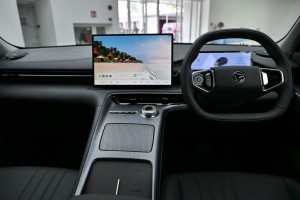LONDON: Lotus has introduced Theory 1, its first concept car that reflects the company's vision for the future of intelligent performance vehicles.
This unveiling also marks the debut of The Lotus Theory, the brand’s new design manifesto centered on three principles: Digital, Natural, and Analogue (DNA).
These principles focus on creating an immersive, human-centric, and performance-driven experience by combining cutting-edge technology with advanced engineering.
Theory 1 embodies this new design philosophy by blending digital and analogue elements.
The Digital aspect emphasises an intuitive and immersive experience, the Natural element highlights emotional and connected design, and the Analogue component continues Lotus's legacy of performance engineering.

The three-seat car, weighing less than 1,600kg, is designed to adapt to the driver’s needs, delivering a tailored and engaging driving experience. The driver sits centrally in the cabin with a passenger on each side.
The Theory 1, like all new Lotus models, is fully electric, equipped with a 70-kWh battery pack and all-wheel drive. According to Lotus, the Theory 1 produces 987 hp and 1,000 Nm of torque, accelerating from 0 to 100 kph in under 2.5 seconds and reaching a top speed of 320 kph. It offers a range of 402 km (WLTP).
Lotus design vice-president Ben Payne said: “With Theory 1, we’ve pushed the boundaries of performance vehicles. We aim to provide an immersive driving experience that combines emotion, functionality, and connectivity.”
The car is part of Lotus’ Vision80 strategy, aiming to transform into a global performance technology brand in the coming years.

Lotus has developed Lotuswear, an advanced driver system designed to provide a personalised in-car experience.
This system uses adaptive robotic textile material to enhance the connection between the car and its occupants, featuring inflatable pods in the seats and steering wheel that provide haptic feedback.
For example, gentle pulses can indicate when to turn.
The system includes five driving modes—Range, Tour, Sport, Individual, and Track—that adjust to the driver’s surroundings, optimising efficiency, performance, and comfort.
Developed in collaboration with MotorSkins, a soft robotics company, this marks the first use of such technology in the automotive context.

Lotuswear also incorporates 3D-printed lattice headrests, developed with carbon, which enhance comfort, reduce weight, and improve aerodynamics.
Integrated into the headrests is a binaural audio system, designed in partnership with KEF, that offers personalised soundscapes for each occupant. The system includes noise-cancelling features and immersive audio, enhancing the driving experience by delivering tailored sound environments.
Lotuswear includes a Technology Line—a functional band running through the car, integrating Oled displays and advanced sensors.
This line acts as a communication device, showing vehicle status to occupants and external users.
The car features a 360-degree sensor suite, including LiDARs, HD cameras, and radars, which provide comprehensive obstacle detection even in low-light conditions.
Built on the Nvidia Drive compute platform, the system processes sensor data at high speeds, enhancing safety and vehicle capabilities. This design is inspired by the functional band found on the iconic Esprit, maintaining minimalistic and harmonious aesthetics.

Theory 1 emphasises a minimalistic user interface, integrating projections, screens, and haptic feedback for a seamless driver experience.
Lotus has adopted a “Challenge of 10” approach, using only 10 main A-surface materials, all chosen for performance, durability, and sustainability.
These materials include recycled carbon fibre, titanium, and elastomeric polyurethane. This approach reflects Lotus’s heritage of simplicity and lightweight construction, aiming to push the automotive industry towards more sustainable practices.
The car incorporates advanced aerodynamics and cooling systems to enhance performance.
Key features include an active rear spoiler, air deflectors, and a contoured underfloor that guides airflow to optimise efficiency. Inspired by the Lotus 49 Formula 1 car, the motor and battery assembly serve as stressed members, reducing weight and complexity.

Theory 1 also features a unique three-seater layout with a central driving position, enhancing visibility and control, while a proprietary door system offers easy access even in tight spaces, addressing a common issue with high-performance vehicles.
Lotus Theory 1 sets a new benchmark for performance and user experience in electric vehicles.
The car features advanced tyres from Pirelli and a high-performance braking system by AP Racing, continuing Lotus’s tradition of innovation in performance engineering.





















